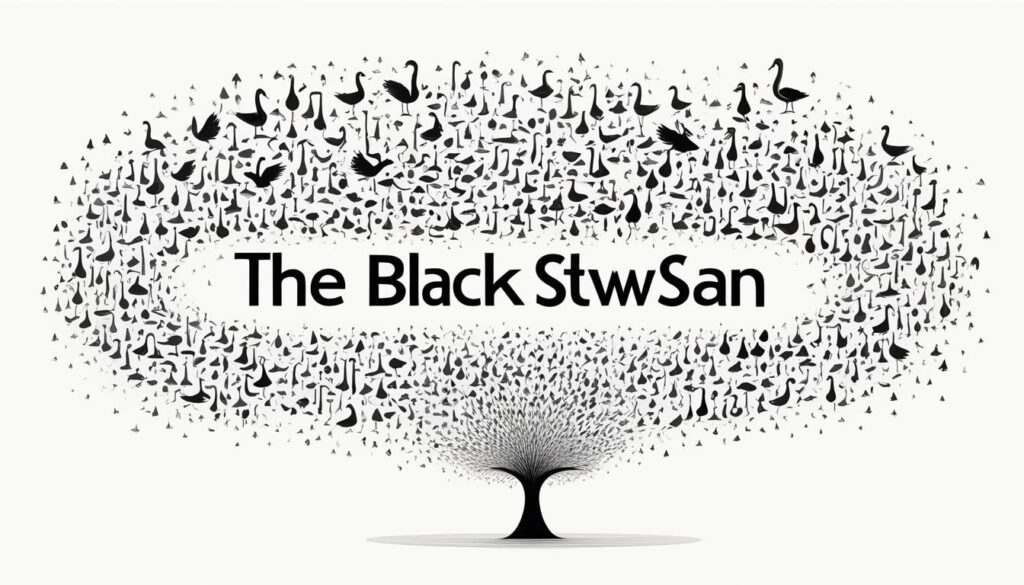In the intricate tapestry of thought challenging conventions in the realm of the global financial markets, Nassim Nicholas Taleb’s book, “The Black Swan,” emerges as a pivotal exploration of unpredictability and randomness. The work delves deeply into the concept of unexpected, rare events that ripple through systems, inducing significant impacts. Taleb, renowned as a risk analyst and philosophical essayist, embarks on a quest to dissect and understand events hidden beyond the veil of predictability.
By coining the term ‘Black Swan,’ Taleb has broadened the horizon of probability and its profound influence over the fields of economics, science, and our individual lives. His book is less a historical account and more an intellectual odyssey that unveils the fallacy of reliance on past occurrences to predict future world events. It invites readers to question, to ponder, and to accept the inherent randomness interwoven into the fabric of existence—a provocative examination that has resonated with professionals and laypersons alike.
Join us as we embark on this enlightening journey through the mind of Nassim Nicholas Taleb and the compelling world of the Black Swan theory—a journey that promises to unveil the enigmatic forces of the highly improbable shaping our world and the financial domains within it.
Unveiling the Mystery of Black Swan Events
Black Swan events, a term popularized by Nassim Nicholas Taleb, envelop the rare and radical occurrences that shatter our expectations and leave long-lasting imprints on society. These anomalies stand on the extremes of the bell curve, invisible to our daily radar, yet possess the potential to redefine the path of history. Understanding the anatomy of these events can empower us to anticipate improbable events, appreciate the unforeseen consequences, and prepare for unpredicted risks.
Understanding Taleb’s Defining Concept
To Taleb, Black Swan events express three defining traits: their outlier status as they lie beyond the realm of regular expectations, their staggering impact, and the human nature to concoct explanations for their occurrence after the fact. This paradox of retrospective predictability showcases our inability to acknowledge the limitations of our foresight. Rather than accepting the uncertainty, we often fall prey to cognitive biases that cannot anticipate these wizards of the unforeseen—the Black Swans.
Historical Examples of Black Swan Events
Delving into the 2008 financial crisis, we observe an economic catastrophe that few predicted, showcasing a classic Black Swan event. Similarly, the rise of the internet transformed our civilization in ways that were hardly imagined when it was in its nascent stages. These instances, alongside the September 11 attacks, epitomize the profound impact and global shake-up associated with such improbable events. By studying them, we glean insights into their unpredictability and the critical lessons they impart about vulnerability in systems global and local.
| Event | Characteristics | Impact |
|---|---|---|
| 2008 Financial Crisis | Rarity, Extreme Financial Turmoil, Global Reach | Economic Downturn, Policy Reformation |
| Rise of the Internet | Unprecedented Technological Leap, Networking | Information Age, New Economies |
| September 11 Attacks | Shocking, Unpredicted, Terror | Geopolitical Change, Security Overhaul |
Nassim Nicholas Taleb: The Mind Behind the Theory
Renowned as a polymath, Nassim Nicholas Taleb stands at the confluence of multiple disciplines. As a philosopher, essayist, and risk analyst, his contributions have sparked significant discussions in the realms of epistemology and randomness. Taleb’s illustrious background in quantitative finance complements his philosophical musings, resulting in the groundbreaking work known as the Black Swan theory.
Taleb’s personal experiences meshed with his expertise in probability and mathematics, leading him to question the conventional accuracies of forecasting and planning. His writings reveal an intricate tapestry of thoughts, drawing upon a rich palette of knowledge that ranges from ancient philosophical wisdom to sophisticated mathematical models. This has orientated him as a seminal figure in understanding the complexities of systemic risks and unpredictable events.
“The inability to predict outliers implies the inability to predict the course of history.” – Nassim Nicholas Taleb
Tapping into the collective curiosity about uncertainty, Taleb has laid bare the limitations of human knowledge. In a world preoccupied with predictions, his work rings as a bellwether call to remodel our approach towards understanding uncertainty. His astute critique of traditional statistical methods and economic theories underscores a bold, interdisciplinary strategy that challenges prevailing norms.
| Contributions | Fields of Impact |
|---|---|
| Black Swan Theory | Risk Management, Probability, Philosophy |
| Critique of Statistical Methods | Statistics, Finance |
| Discussion on Epistemic Arrogance | Epistemology, Decision-making |
| Interdisciplinary Approach | Quantitative Finance, Literary Essayism |
Through his prolific career, Taleb has not only authored influential works but has also translated his theories into practical advice. His advocacy for a world that acknowledges and adapts to randomness rather than vainly striving to predict it outright has redefined our grasp on the fabric of reality and shaped the way we perceive the improbable.
In-depth Analysis of the Book’s Core Principles
Nassim Nicholas Taleb’s work “The Black Swan” delves into the intricate world of risk management and uncertainty, presenting a stark contrast between theoretical models and the unpredictability of real-life events. It is pivotal to recognize how the book emphasizes the impact of human error in predictions and how psychological biases color our perception of potential risks.
The Psychology of Risk and Uncertainty
The book’s examination of our psychological approach to understanding risks lays bare the inherent flaws in human judgment when faced with unknowns. Taleb’s reliance on robust empirical evidence exposes the confirmation bias and narrative fallacy—preferences for information that supports our preconceived notions and storytelling over hard facts. These biases spotlight the challenges we face in accurate risk assessment and decision-making under uncertainty.

Statistics Versus Reality: When Predictions Fail
Furthermore, “The Black Swan” critically evaluates the reliability of statistical models when they clash with real-world incidents. This contrast between theory and practice represents a gap where conventional prediction models frequently miss unforeseen Black Swan events. Such incidents, which escape the purview of normal expectations due to rarity and extreme impact, compound the discrepancies between what is predicted and what actually transpires, illustrating the limits of our forecasting capabilities.
| Element of Risk Perception | Influence on Risk Management | Impact of Psychological Biases |
|---|---|---|
| Historical data reliance | Limited effectiveness against non-recurring events | Overconfidence in patterns |
| Confirmatory information | Creates blind spots in risk assessment | Confirmation bias and neglect of disconfirming evidence |
| Narrative coherence | Favors plausible stories over statistical rarity | Preference for cohesive stories over disjointed facts (Narrative fallacy) |
| Projection of the familiar | May disregard novel threats | Anchoring on known quantities and disregarding unknown unknowns |
In sum, Taleb illuminates the limitations of current risk analysis methods while arguing for a more robust system that can withstand the test of unpredictability. By dissecting the human error in predictions and our innate psychological biases, he urges both individuals and institutions to recalibrate their understanding of uncertainty and adopt more resilient strategies for risk management.
Exploring Predictability in an Unpredictable World
The quest for dominance over our futures often leads us to lean heavily on predictive models, tools that promise a glimpse into the likelihood of forthcoming events. Nassim Nicholas Taleb’s insights remind us that injecting an excessive dose of confidence into these models can be a recipe for overlooking the profound uncertainty principle that governs the tapestry of life. As Taleb imparts in “The Black Swan,” to respect the capricious nature of reality is to recognize the prevalence of human fallibility in predictions.
Our reliance on analytics and data-driven foresights, while at times remarkably accurate, must accommodate the erratic whims of randomness. Complexity in systems—be it environmental, financial, or technological—introduces innumerable variables that interact in unforeseen ways, concealing outcomes beyond the edge of our computational powers.
The wise man is he who knows the relative value of things. – William James
As such, Taleb encourages a pivot from the pursuit of precision in prediction to the cultivation of resilience and robustness. Instead of aiming to forecast every twist and turn, we can construct frameworks and institutions that weather turbulences, adapting and even thriving amidst disruptions.
- The role of robustness in systems design
- Strategies to embrace uncertainty rather than futilely attempting to eliminate it
- The implications of randomness on historical processes and their interpretations
In aligning with Taleb’s perspective, we witness the futility in attempting to outguess the markets or predict geopolitical shifts with absolute certainty. It’s an exercise that compels us to acknowledge the limits of our tools and intellect, urging us to instead foster an environment, whether in business or personal realms, that is not just resistant to shocks but capable of leveraging them for positive transformation.
Adopting this mindset does not depreciate the value of qualified estimations or careful planning; rather, it places them within a realistic frame that accepts the unknown as an integral part of the equation. It’s a profound shift—from a belief in certainty to a natural acceptance of life’s inherent ambiguity and unpredictability. In the end, it’s this graceful dance with uncertainty, respecting its boundaries while preparing for its surprises, that Taleb posits as our best strategy for navigating an unpredictable world.
“The Black Swan” Phenomenon in Modern Economics
The concept of the Black Swan has rippled through the discipline of economics, introducing a new dimension to the understanding of economic unpredictability. Nassim Nicholas Taleb’s insights have emphasized the necessity of acknowledging the inherent limitations of our economic foresight, especially within the financial sectors that exhibit considerable market vulnerability. This has sparked robust discussions on the adequacy and reliance of financial forecasting methodologies.
The Financial Industry’s Vulnerability to Improbable Events
Financial markets are complex entities that have traditionally been viewed as predictable systems to a certain degree. Taleb’s Black Swan concept challenges this perspective, highlighting how improbable events can and have led to systemic shocks that catch even the most sophisticated market participants off-guard. The vulnerability of these markets to unpredictable events manifests itself most clearly in sudden economic downturns and crises, where standard forecasting models quickly become obsolete.
Critiquing the Market’s Ability to Forecast
Criticism aimed at the market’s ability to forecast has grown louder in the wake of Black Swan events. Taleb himself has expressed skepticism towards the heavy reliance on financial modeling, which often underestimates the probability and impact of outlier events. This has prompted an investigative discourse on how financial institutions can better equip themselves against future unpredictability, questioning the very foundations upon which many financial strategies are built.
The exploration of these themes within the financial industry has fundamentally altered how economic experts approach the constantly evolving challenge of potential Black Swan events. This discourse continues to stress the importance of building systems and paradigms that remain robust in the face of the unknown—a testament to the enduring legacy of “The Black Swan” in modern economic thought.
How “The Black Swan” Influences Decision Making
In grappling with the unpredictable nature of Black Swan events, organizations and individuals alike confront significant challenges in strategic planning. Nassim Nicholas Taleb encourages a paradigm shift from traditional predictive methods to a focus on preparation and adaptability, counting on our inherent risk aversion and the ability for cognitive reframing to accommodate for unknown risks. This approach mandates critical alterations in conventional decision-making processes.

One significant concept from Taleb’s work is the notion that unexpected events demand not only an awareness but also an acceptance of the limits of our foresight. Consequently, strategic planning must evolve to emphasize flexibility and resilience over mere prognosis. This shift in mindset is profoundly rooted in cognitive reframing, where potential threats are not solely seen as risks, but also as potential opportunities for growth and innovation.
As a response to the unpredictability highlighted by Taleb, organizations are re-evaluating their risk management protocols, integrating a higher degree of risk aversion, not to avoid risk entirely, but to build systems capable of withstanding sudden shocks. Here is a comparative look at traditional vs. Taleb-influenced decision-making frameworks:
| Aspect | Traditional Approach | Taleb-Influenced Approach |
|---|---|---|
| Focus | Prediction-based | Preparation-centric |
| Planning | Fixed, Inflexible Strategies | Adaptive, Robust Strategies |
| Perception of Risk | Seen as a negative to be minimized | Embraced as an inherent aspect of uncertainty |
| Response to Change | Reactive | Proactive and Dynamic |
| Learning | Based on historical data | Leverages experiences as opportunities to increase resilience |
The importance of Taleb’s insights on decision-making reaches beyond the confines of corporate strategy into the personal realm, where individual decision-makers are urged to adopt a more mindful approach towards future uncertainties. This process is greatly aided by cognitive reframing, allowing individuals to perceive unforeseen events not solely as detriments but as catalysts for personal growth and development.
A fundamental takeaway from “The Black Swan” is the recognition that no amount of planning can predict every outcome. Therefore, by enhancing our capacity for resilience and agile response, we can navigate through the tempestuous seas of randomness and chaos with a greater sense of confidence and composure.
‘Antifragile’ Systems and Embracing Uncertainty
In the wake of Nassim Nicholas Taleb’s influential work “The Black Swan,” the concept of antifragility emerged as a groundbreaking approach to handle the inherent unpredictability of our world. This perspective suggests a shift from merely weathering chaos to creating systems that thrive and enhance their capabilities when exposed to it. By championing antifragility, Taleb has provided a comprehensive blueprint for individuals and organizations to transcend robustness and craft adaptable strategies that excel amid disruption.
Taleb’s Follow-Up: Strengthening Against Chaos
Post “The Black Swan,” Taleb continued to interrogate the essence of randomness and its role in shaping our reality. His follow-up elucidates on creating structures that do not just withstand the test of chaos but prosper because of it. With chaos preparation, we move beyond the anticipation of potential calamities and orient our systems towards continuous improvement in the face of volatility.
Creating Robust Solutions in a Black Swan World
Reconstructing our paradigm to appreciate the value of antifragility involves recalibrating the fundamentals of robust systems to confer them an edge in dynamic environments. Adaptable strategies are essential to harness the unpredictability of Black Swan events. By integrating adaptability as a core tenet, systems become inherently more resilient and innovation-driven, capable of not just surviving but evolving through shocks and stresses.
Real-world Impact: Black Swan Events Post-Publication
Since the release of “The Black Swan,” by Nassim Nicholas Taleb, the concept of crisis anticipation has fundamentally altered how industries and governments consider global impact assessments and prepare for future unpredictability. The book’s ideas have gained increasing relevance as we witness unprecedented events that retrospectively fit the Black Swan criteria.
Spotting Swans: Before and After Major Crises
The global landscape has been significantly marked by events that have tested our foresight and crisis management protocols. From the economic aftershocks of the 2008 financial crisis to the more recent COVID-19 pandemic, societal capacity for crisis anticipation has been put under the microscope. These events underscore the necessity for improved mechanisms for spotting potential Black Swan events, even though they are, by their very nature, unpredictable.
The Global Landscape: Contemplating Future Swans
With global interconnectedness on the rise, the potential for Black Swan events that affect multiple spheres simultaneously is a pressing concern. Future unpredictability in socio-economic, technological, and environmental arenas compel a shift in global impact assessments, calling for future-proof strategies against such high-impact events.
The table below outlines notable post-publication Black Swan events and their effects, demonstrating the necessity for dynamic anticipation frameworks and comprehensive impact assessments:
| Event | Impact | Reflection and Adaptation |
|---|---|---|
| Global Financial Crisis (2008) | Widespread economic downturn, market instability | Increased regulation and stress-testing within financial sectors |
| Fukushima Nuclear Disaster (2011) | Environmental damage, energy policy reevaluation | Strengthened international safety standards for nuclear facilities |
| COVID-19 Pandemic (2019-) | Health, economic, and social disruption on a global scale | Advancements in vaccine technology, shift towards remote work, increased focus on healthcare system resilience |
In summary, the imperatives of modern society, defined by intricate networks and rapid developments, require a vigilant approach to crisis anticipation, with global impact assessment processes being constantly refined to address future unpredictability.
Audiobook Review: “The Black Swan’s” Narration Excellence
Delving into an audiobook review, it’s not just the content that informs and engages but also the audiobook narration that brings the text to life. The auditory nuances of tone, pace, and emotion can remarkably transform the audiobook listening experience. Let’s explore how “The Black Swan’s” audiobook stands out in its delivery and makes Taleb’s dense content captivate the listener.
Evaluating the Narrator’s Performance and Tone
The effectiveness of an audiobook often hinges on the narrator’s performance. In the case of Taleb’s audiobook, the clarity and tone of the narration are pivotal to the listener’s comprehension and retention. With concepts that initially might seem esoteric to the uninitiated, the narrator has the dual task of both educating and enthralling the audience.
The Experience of Consuming Ideas Through Audio
Audiobooks offer a distinct listening experience that demands a nuanced blend of attention and imagination. Consuming Taleb’s profound ideas on unpredictability and randomness is an expedition that the audiobook format turns into an accessible journey. Below is an assessment of how the audiobook’s narration contributes to the understanding and enjoyment of “The Black Swan.”
| Aspect of Narration | Contribution to Taleb’s Audiobook | Overall Listening Experience |
|---|---|---|
| Pronunciation & Enunciation | Critical for grasping complex terminology and nuanced arguments | Provides a comfortable and clear listening flow, avoiding confusion |
| Consistency of Tone | Maintains the thematic gravitas and seriousness appropriate to the content | Ensures the listener remains grounded in the book’s academic intent |
| Emotional Rendering | Infuses Taleb’s passion for the subject matter, enriching the audiobook version | Facilitates deeper engagement and personal connection with the text |
| Pacing | Allows time for reflection and understanding complex ideas without haste | Aids in absorbing and contemplating the implications of Taleb’s theories |
A more intangible yet equally significant factor is the unique bond formed between the narrator and listener. Strategic pauses, intonation changes, and the slightest emotive cues signal a deeper dive into Taleb’s provocative insights, ensuring the audiobook review of “The Black Swan” is not merely about content consumption, but an immersive intellectual experience.
Lessons Learned from “The Black Swan”
Nassim Nicholas Taleb’s “The Black Swan” illuminates a path towards embracing randomness in our personal and professional lives. The book’s profound insights remind us that the unexpected is not only possible but probable. By admitting the limitations inherent in forecasting the future, we unleash the potential to adapt and thrive amidst unforeseen circumstances.
As a society, we’re beginning to appreciate that learning from uncertainty is a valuable skill. Decision-making, both in financial investments and policy formation, is shifting from a reliance on predictions to embracing adaptive strategies that account for the myriad of possibilities that lie outside our predictions. This change in outlook is a direct outcome of understanding Taleb’s philosophy of Black Swan events.
The concept of a Black Swan pushes us to develop systems and approaches that are not just resistant to chaos, but that can also evolve and improve when tested by crisis. Instead of retreating into the comfort of false certainty, the book encourages individuals and institutions to build a fortitude that is versatile and dynamic—a true reflection of nature’s own complex systems.
In the following table, we consider the direct applications of Taleb’s wisdom on various spheres of life and quantify the potential impact of incorporating Black Swan thinking into everyday practices:
| Aspect | Traditional Approach | Black Swan Inspired Approach | Impact Potential |
|---|---|---|---|
| Investment Strategy | Focus on historical trends | Varied portfolio with uncorrelated investments | High |
| Policy Making | Rigid plans based on precedent | Flexible frameworks allowing quick adaptation | Medium |
| Personal Growth | Linear career paths | Continuous learning and skills diversification | High |
| Crisis Management | Reliance on predefined protocols | Stress-testing and resilience building exercises | Medium |
By synthesizing the primary teachings from “The Black Swan,” we’re urged to think critically about the fabric of our reality. Instead of fearing the chaos of randomness, there’s clear merit in scenario planning that stretches our imagination beyond the conventional. In an unpredictable world, recognizing the potential for the improbable arms us with a greater capacity to respond confidently and competently to whatever challenges may come our way.
Conclusion
In the exploration of Nassim Nicholas Taleb’s profound work, “The Black Swan,” we are led to a striking realization: uncertainty is not to be feared, but embraced. Through Taleb’s legacy, we have been invited to scrutinize our perceptions of probability and risk, unraveling the layers of complexity that govern the unpredictable nature of our world. His insightful theory not only draws from the depths of probability and philosophical thought but also extends a hand towards practical, everyday decision-making.
Final Thoughts on Taleb’s Contributions to Understanding Improbability
The Black Swan theory has irreversibly changed how we perceive the fabric of randomness that intertwines with our lives. By elevating our understanding of improbable events, Taleb reshaped the domain of risk management and strategic foresight. His intellectual bravery in addressing the unknowns has underscored the necessity of fostering resilience in the face of inexplicable phenomena. While embracing uncertainty might run counter to human instinct, Taleb has shown it to be a fundamental aspect of navigating and thriving in our complex society.
How to Equip Ourselves for the Highly Improbable
Preparing for the unknown remains one of the most challenging quests for individuals and institutions alike. As we contemplate the future, equipped with the insights of “The Black Swan,” we are called upon to reevaluate the robustness of our systems and the adaptability of our strategies. The quest is not to predict the unpredictable but to build a greater capacity to withstand and benefit from the unexpected. Taleb’s contribution lays a solid foundation for a more vigilant and adaptable approach to the highly improbable events that inevitably bookmark chapters in the annals of human history.



